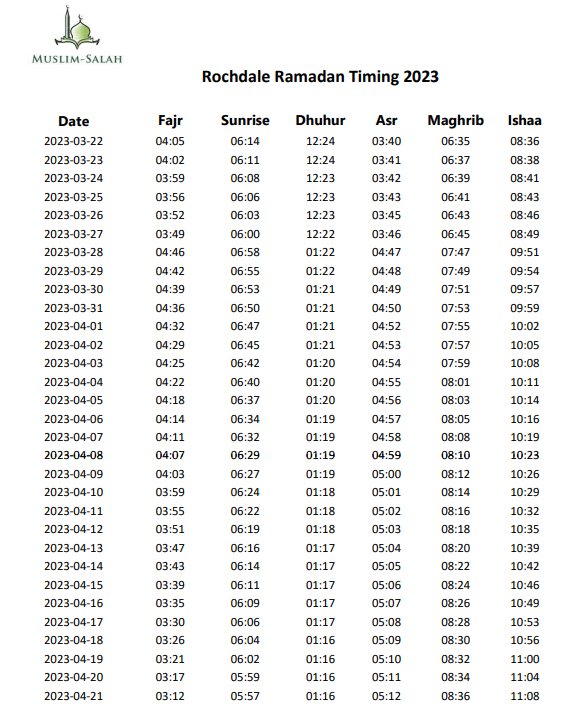Ramadan Timetable Rochdale 2023
Rochdale Ramadan Timetable 2023
Rochdale Ramadan Timetable 2023 provides you the latest information on Rochdale Sahur times and Rochdale iftar times. With the Rochdale Ramadan Timetable 2023 you can find out the prayer times on a daily basis.

Ramadan Timetable 2023 in Rochdale
Alhamdulillah! The blessed month of Ramadan is coming again with all its blessings. Muslim brothers and sisters around the world have been looking forward to this month to worship Almighty Allah and to experience the spirit of the blessed month of Ramadan.
What time is iftar in Rochdale today?
The holy month of Ramadan comes to bless the Islamic world with its spiritual beauties. In this blessed month, believers practice fasting.
„What time is Sahur in Rochdale? Our brothers and sisters who are curious about answers to questions like“ What time is Iftar in Rochdale? „, can download the Ramadan schedule on their computer or phone.
When is Ramadan 2023 in Rochdale?
Ramadan is approaching, the holy month of worship when Muslims gather at iftar tables and homes are filled with peace and prosperity. This year, Ramadan 2023 begins on March 22, 2023 and ends on April 21, 2023
- First Day of Ramadan: Wednesday, March 22
- Last Day of Ramadan: Friday, April 21
- Eid al-Fitr Day 1: Saturday, April 22
- Eid al-Fitr Day 2: Sunday, April 23
- Eid al-Fitr Day 3: Monday, April 24
Fasting in Ramadan
Numerous regulations order the timing, as well as the correct religious fasting and behavior in the month of Ramadan.
Thus, an extensive literature has grown up around the determination of the beginning and end of the month of Ramadan and the beginning and end of each day of fasting. The exact determination of prayer times, months, and feast days has driven the sciences of mathematics, astronomy, and geography in particular in the Islamic world since the emergence of Islam.
All Muslim feast days, including Ramadan or the pilgrimage to Mecca (Hajj) are once in summer and then again in winter. What is the reason for this? Solar calendar systems, such as the calendar used in Germany, are aligned according to the course of the sun. The months are fixed in relation to the seasons and a solar year lasts about 365 days. However, since the Islamic calendar is aligned with the moon, the Islamic year lasts only 354 days and 8 hours. The Islamic year is about 10-11 days shorter than the solar year, with its progression adjusted to the length of the seasons. In relation to the solar calendar, the dates of Islamic holidays and months therefore shift by about 10-11 days. The month of Ramadan therefore begins at dawn after the appearance of the new moon. In different religious centers of the Islamic world, scholars calculate the beginning and end of Ramadan respectively. Therefore, according to the geographical position, the beginning and end of Ramadan may differ slightly.
Dua for Breaking Fast
اللَّهمَّ أَهلَّهُ علينَا بالأمنِ والإيمانِ والسَّلامةِ والإسلامِ ربِّي وربُّكَ اللَّهُ
Allahumma ahillahu alayna bil-amni wal-iman was-salaamati wal-islam. Rabbi wa rabbuka Allah
Oh Allah, make it a start full of peace and faith, safety and Islam. My Lord and your Lord is Allah
